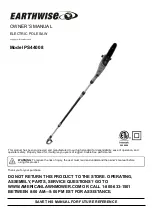
15
OPERATION
FIGURE 16
TO SLIDE CUT
Never make a cut by pulling the saw
toward you. The blade can “climb” on
top of the workpiece and come toward you at an
accelerated speed. Failure to heed this warning could
result in serious personal injury.
See Figure 16
With the saw off, pull the saw arm forward. Turn the saw
on (wait for blade to reach full speed). push the blade
down cutting into the workpiece, then back toward the
rear of the saw to make a cut. Cuts must be made by
pushing the saw blade away from you and toward the
back of the saw stopping at the maximum rear position
after each cut. While the saw is running,
NEVER
pull the
saw blade toward you or toward the front of the saw. See
warning above.
• Raise arm to its full height.
• Place the workpiece flat on the miter table with
one edge securely against the fence. If the board is
warped, place the convex side against the fence. If
the concave edge of a board is placed against the
fence, the board could collapse on the blade at the
end of the cut, jamming the blade. See Figure 16.
• When cutting long pieces of lumber or molding,
support the opposite end of the stock with a stand or
with a work table level with the saw table.
• Align the cutting line on the workpiece with the blade
or laser line.
• Loosen the slide lock knob.
• Hold the stock firmly with one hand, against the
fence. Use the work clamp to secure the workpiece
whenever possible.
• With the saw off, perform a dry run of the cut to
make sure that no problems will occur when the
actual cut is made.
• With the saw off, grasp the saw handle firmly then
pull the saw forward until the center of the saw blade
is over the front edge of the workpiece or until the
saw is fully extended.
• Squeeze the switch trigger. Allow the blade to reach
maximum speed.
• Slowly lower the blade through the front edge of the
workpiece.
• While holding the workpiece push the saw handle
away from you and toward the back of the saw.
• Release the switch and allow the saw blade to stop
rotating before raising the blade out of workpiece.
After blade stops, remove the workpiece from miter
table.
NOTE:
A cross cut is made by cutting across the grain of
the workpiece. A straight cross cut is made with the miter
table set at the 0° position. Miter cross cuts are made
with the miter table set at some angle other than 0°
BEVEL CUTS
A bevel cut is made across the grain with the blade
angled to the workpiece. A straight bevel means the miter
scale indicator is set at 0° and the bevel scale indicator is
set at an angle other than 0°.
COMPOUND MITER CUTS
A compound miter cut is made using a miter angle and a
bevel angle at the same time. Adjustments of miter and
bevel settings are interdependent. Each time you adjust
the miter setting change the effect of the bevel setting.
Also, each time you adjust the bevel setting you change
the effect of the miter setting.
Summary of Contents for S26-261L
Page 69: ...69 NOTES REMARQUES NOTAS ...
















































